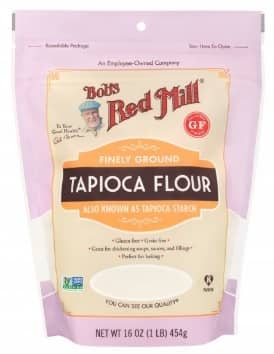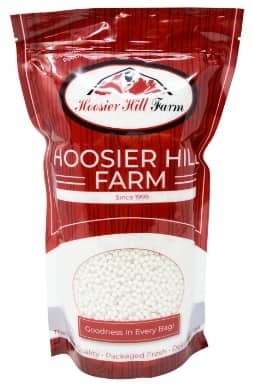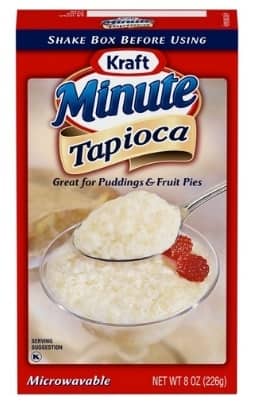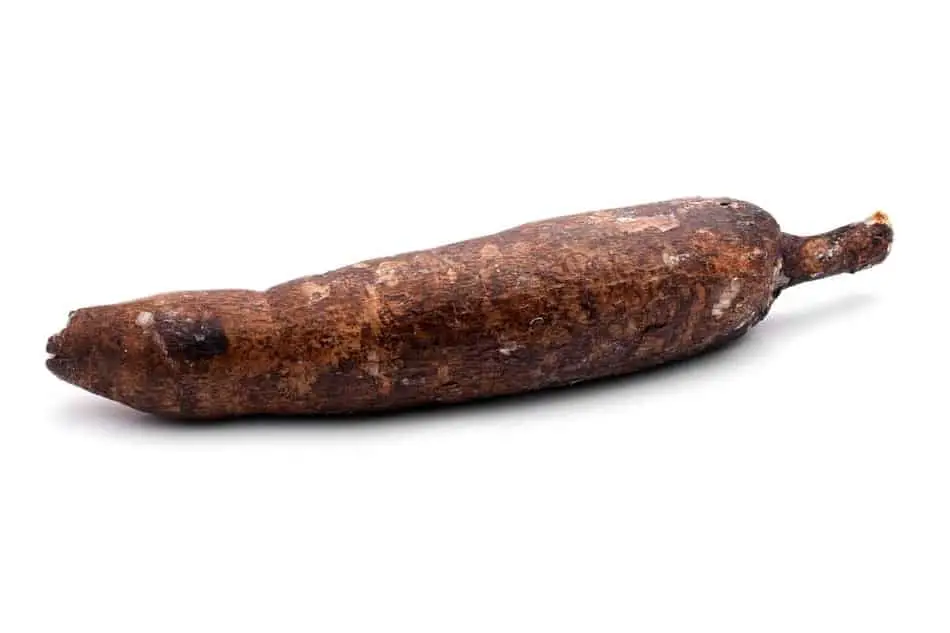Tapioca is a common ingredient that you’ve no doubt run across when scanning labels. A lot of folks are unaware of how it’s derived and want to know if any animals are involved in its cultivation and production.
Is it vegan? Yes, tapioca is vegan because it’s simply a starch extracted from storage roots of the cassava plant.1 Industrially, the starch is processed into a few different forms including tapioca meal, soluble powder, pre-cooked course/fine flakes, spherical “pearls”, and rectangular sticks.2
Production of food-grade tapioca root involves removing some of the toxic ingredients. Or, at least, for some varieties of the root. For example, the green-branched variant requires removal of linamarin, a glycoside capable of producing hydrogen cyanide which is a known toxin.3
Weeks of near-exclusive consumption of poorly-processed cassava is enough to result in a paralytic disease known as konzo aka mantakassa.
Anyway, what we’ll do here is go over the various forms of processed food-grade tapioca in both vegan and non-vegan applications.
Tapioca in Vegan Food Products
Pure Tapioca Flour

This stuff is multi-purpose and can be used for a number of food products. It’s 100% tapioca, so it’s 100% vegan.
For example, Bob’s Red Mill Tapioca Flour lists tapioca as the sole ingredient.4
Vegan Egg Replacements

Tapioca is a common source of starch for various food products. Starch comes as amylose and amylopectin. The relative amounts of the two starches determine a given plant matter’s ability to hold water.
The higher the amylose content, the more the plant matter will gel and form a solid structure when exposed to water and heat.
Tapioca tends to be higher in amylopectin, so it gels a bit less than its higher amylose cousin cornstarch.5
A good egg replacement is one that holds water. When cooked, the heat coagulates the egg protein, allowing the proteins to serve as an adhesive, binding a mixture’s ingredients to the surface of the cooked material, which provides structural strength.6
Even though tapioca flour is relatively less effective in gelling, it still tends to be used in egg replacements.
For example, Bobs Red Mill Natural Foods Egg Replacer uses a mixture of different starches including tapioca.7
Tapioca Pearls (Bubble Tea, Etc.)

This is not to say that all bubble tea is vegan-friendly as some may contain milk products. But, the tapioca pearls you’ll encounter in bubble tea area perfectly suitable for vegans.
For example, Hoosier Hill Farm’s Large Tapioca Pearls simply reads “tapioca” in the ingredients, and nothing else.8
Pearls are the most widely available form of bulk food-grade tapioca. Sizes range anywhere from around 1 mm to 8 mm in diameter, with the 2–3 mm size being the most common.9
So, this is good news for vegans. Pearls kind of have that gelatin texture, so folks often want to know if their vegan.
Fortunately, the gelatin texture can be achieved through various plant sources like tapioca. After all, the term “gelatinization” refers to the process by which the intermolecular bonds of starch molecules break down in the presence of water and heat.10
Tapioca Pudding Mix

Kraft Precooked Tapioca contains just tapioca and soy lecithin so it’s 100% vegan.11
It’s sold for use in tapioca pudding and other desserts. Lecithin, in this case, is derived from soy instead of egg. Lecithin is just an emulsifier which is a compound that allows ingredients to mix by attracting both water and fat molecules holding them together.12
Tapioca In Non-Vegan Products
Just because the substance is 100% vegan, doesn’t mean every application of the product involves vegan-friendly foods.
Meat
Meat manufacturers have long wanted to reduce the fat content of their beef products to appeal to health-conscious crowds. The problem is that, when you reduce fat too much, consumer acceptance takes a hit because very low-fat meat is less flavorful and has a less desirable mouthfeel.
Consumer preference studies have demonstrated that ground beef containing anywhere from 15% to 20% fat is preferred.13 If you go below 20%, the flavor, juiciness, and tenderness really suffer.
To address the problem, some manufacturers have turned to tapioca starch to increase consumer acceptance of low-fat meat. It seems that modified tapioca starch plus sodium alginate improves the properties of low-fat beef quite a bit.13
Commercial Tapioca Pudding
Above, it was mentioned that at least some tapioca pudding mixes are 100% vegan. That’s because the consumer has yet to add in the rest of the ingredients which are traditionally animal-derived.
When making homemade pudding, vegans need only swap out animal products (e.g. milk) for plant-based alternatives.
Pre-made tapioca pudding, on the other hand, comes prepackaged with milk and eggs.
For example, Kozy Shack Simply Well No Sugar Added Gluten-Free Tapioca Pudding contains:14
- Reduced fat milk
- Tapioca
- Egg whites
- Inulin
- Modified tapioca starch
- Natural flavors
- Salt
- Sucralose
- Annatto extract
Jell-O Ready to Eat Tapioca Pudding includes a few extra non-vegan ingredients:15
- Skim Milk
- Water
- Sugar
- Tapioca
- Modified Cornstarch
- Hydrogenated Vegetable Oil (Coconut And Palm Kernel Oils)
- Salt
- Sodium Stearoyl Lactylate (For Smooth Texture)
- Sodium Alginate
- Calcium Phosphate
- Natural And Artificial Flavor
- Soy Lecithin
- Artificial Color—Yellow 5 and Yellow 6
- Vitamin A Palmitate
- Vitamin D
If you really like tapioca pudding, a quick search should render a number of vegan variations of the original recipe.
That wraps it up for tapioca. Thanks for reading.
You may also want to check out the following related articles:
References
- Tapioca. https://en.wikipedia.org/wiki/Tapioca
- Tapioca Production. https://en.wikipedia.org/wiki/Tapioca#Production
- Food and Agriculture Organization of the United Nations, “Roots, tubers, plantains and bananas in human nutrition”, Rome, 1990, Ch. 7
- Bob’s Red Mill Tapioca Flour. https://www.bobsredmill.com/tapioca-flour.html
- Understanding Food: Principles and Preparation (Page 43). Amy Brown – Wadsworth Cengage Learning – 2011
- Understanding Food: Principles and Preparation (Page 256). Amy Brown – Wadsworth Cengage Learning – 2011
- Bobs Red Mill Natural Foods Bobs Red Mill Egg Replacer. https://www.bobsredmill.com/gluten-free-vegan-egg-replacer.html
- Hoosier Hill Farm Large Tapioca Pearls. https://hoosierhillfarm.com/Hoosier-Hill-Farm-Large-40-Tapioca-Pearls-2-lbs..html
- Carolina Moura. “How to make tapioca pearls”. Snapguide.com
- Starch gelatinization. https://en.wikipedia.org/wiki/Starch_gelatinization
- Kraft Tapioca Pudding. https://www.heb.com/product-detail/kraft-minute-tapioca-pudding-mix/135926
- Anton M, and G Gandemer. Composition, solubility, and emulsifying properties of granules and plasma of egg yolk. Journal of Food Science 62(3):484–487, 1997.
- Berry BW. Sodium alginate plus modified tapioca starch improves properties of low-fat beef patties. Journal of Food Science 62(6): 1245–1249, 1997.
- Kozy Shack Simply Well No Sugar Added Gluten-Free Tapioca Pudding. https://www.kozyshack.com/products/simply-well/simply-well-tapioca-pudding
- Jell-O Ready to Eat Tapioca Pudding, 4 ct – 15.5 oz Package. https://www.instacart.com/safeway/products/16644-jell-o-ready-to-eat-tapioca-pudding-snack-3-875-oz

